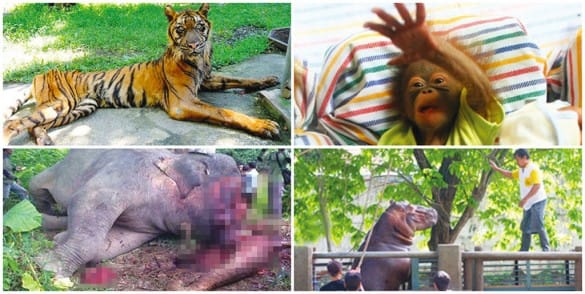
A Concentration Camp for Animals
Even in optimal conditions, zoological gardens, or ‘zoos’, are often golden jails for the imprisoned animals. When the conditions and the care of these animals are inhumane, a prison becomes a concentration camp. In the Surabaya Zoo, probably one of the worst zoos in the world, animals are dying at an astounding rate.
Modern zoos declare that the exhibition of wild animals is primarily for the conservation of such endangered species, as well as for research purposes and education, and secondarily for the entertainment of visitors. I understand that for many people living in big cities, a visit to the local zoo may be the only way to see (ex) wild animals. However, we should expect a guarantee that every effort is made to maintain the animals’ good health, both physically and mentally.
Even when the ‘educational’ and ‘conservation’ purposes are respected, they remain questionable; the creation of natural reserves in the wild and the protection of the habitat of endangered species have been already demonstrated as the right way to get important results in the conservation field. Very few zoological gardens or aquariums in the world are really successful in breeding endangered species, and I have never heard about some of them actively reintroducing endangered animals back to the wild.
The Surabaya Zoo, or Kebun Binatang Surabaya (KBS), was founded in 1916 and is one of the largest zoos in Southeast Asia, covering 37 acres and housing over 350 species; home to around 4,000 animals. In the last few months, more than 50 animals have died in KBS and about 600 have died since 2010. The Jakarta Globe reported that 43 animals died at the zoo between July 15 and September 17, 2013.
The zoo’s spokesperson declared that these animals died because “they were old or had diseases”. Could these be diseases like that of a Sumatran Tiger (heavily endangered in the wild), whose digestive tract was rotted away after it was routinely fed with formaldehyde-laced meat? There are fewer than 400 Sumatran tigers left in the world. How can it be possible to mistreat such a precious animal? 10 Sumatran tigers (about 3% of the total world population of this species) still live in the Surabaya Zoo, where they will probably die without having the chance to reproduce.
“The holding facilities were shocking, wet all the time,” said Tony Sumampau, the head of the Indonesian Zoological Parks Association and now a consultant to the zoo after the former management was removed. “Most of the animals died because they got pneumonia, lung disease, TB, or from digestion problems because of the food supply.” Nothing short of a “total renovation” is needed, he said. “We need to either think about privatizing or transferring out some of the animals.”
The meat was apparently supplied by a staff-run business. They bought it cheap then sold it to the zoo at a big mark-up to make more money. Another staff-owned company cut weeds from the side of the heavily polluted Surabaya River to sell for herbivore food. Some other staff are responsible for the disappearance of animals like some Komodo Dragons, probably sold on the black market. Apparently KBS staff is divided into two different factions linked to two former zoo employees, both of them claiming to be the Zoo’s Chief, but was fired in the last few years. This internal conflict even led to the poisoning of a Javan warthog, found with traces of cyanide in his stomach.
“One side is always trying to discredit the other,” said Ludvie Achmad, head of a local conservation agency. Sumampouw acknowledged he has had little success in controlling the undisciplined staff.
Orangutans are left dying in their enclosures, sharing their space with rats, while some nature reserves in Kalimantan are actively working to reintroduce rescued orangutans in their habitat. Elephants, animals that normally walk more than 50 km per day in the wild, are tethered with chains, making it impossible for them to make a single step. The efforts of the animals to get rid of the chains have caused lacerations on their skin, resulting in a painful infection. Avian cages are heavily overpopulated with pelicans, herons and ibises. All of them are not endangered species, so there is absolutely no need to keep so many of them in such a limited space. The breeding of some species is totally out of control.
Like almost everywhere in Indonesia, plastic rubbish inside the Surabaya Zoo is a huge problem. One giraffe died last year with 20 kg of plastic bags in its stomach after they blew into its cage and weren’t cleared. It was relying almost only on the food provided by the visitors, and packed candies were a predominant part of its diet. Groups of Proboscis monkeys are left scavenging in the rubbish bins, which are rarely emptied by the zoo’s staff. Sheep and goats chew on plastic bags. A local group of environmentalists’ called Saatnya Diet Tas Kresek, aiming to stop the use of plastic bags inside the zoo’s facilities, had no success and animals are still eating and chewing plastic.
These conditions, as horrifying as they are, have actually improved in the last three years, since a temporary management was installed by the local government to try and stop the bad image and the complaints received. Apparently, even if some little improvements are made, we’re still very far from guaranteeing the animals’ survival in the zoo. It’s not enough and further actions should be taken. A report by an independent team set up by Indonesia’s forestry ministry called for the animals to be moved to other zoos, but nothing has been done yet. Other Indonesian zoos refused to take the animals because of their condition and the fear that many of them carry diseases.
Ian Singleton, the director of the Sumatran Orangutan Conservation Program, says Indonesia’s 40 zoos are “still highly unregulated and simply milking the small entrance fees”. All but a handful fail to meet international standards.
Many important petitions have been launched to ask the Indonesian government to close KBS and guarantee the imprisoned animals the necessary care they need. The change.org petition (http://www.change.org/petitions/dr-susilo-bambang-yudhoyono-close-surabaya-zoo) has already reached almost 150,000 signatures, but many other are still ongoing. The imprisoned animals cannot fight for their freedom by themselves; they urgently need our help.




